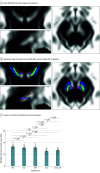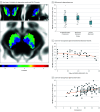Neuromelanin-Sensitive MRI Contrast and Chronic Depression in Young Women
- PMID: 40986300
- PMCID: PMC12457983
- DOI: 10.1001/jamanetworkopen.2025.33339
Neuromelanin-Sensitive MRI Contrast and Chronic Depression in Young Women
Abstract
Importance: Whether chronic depression can be distinguished from nonchronic depression by mesolimbic dopamine hypofunction is a long-standing but untested hypothesis.
Objective: To determine whether cumulative mesolimbic dopamine function, assessed with neuromelanin-sensitive magnetic resonance imaging (NM-MRI) contrast, is associated with chronic depression in young women.
Design, setting, and participants: In the Adolescent Development of Emotions and Personality Traits (ADEPT) prospective cohort study, depressive disorders in women were assessed by diagnostic interview at regular intervals from ages 14 to 22 years (between July 2, 2012, and March 5, 2021). The current analysis includes a subset of ADEPT participants (aged 20-24 years) who completed a cross-sectional NM-MRI imaging study conducted between June 15, 2019, and May 31, 2021. Data were analyzed from March 27, 2024, to June 30, 2025.
Main outcomes and measures: Course of depression was rated using semistructured interviews. The nonparametric permutation test (whole-mask voxelwise analysis) of NM-MRI contrast in 2060 voxels within the substantia nigra and ventral tegmental area complex was used to test the association of cumulative mesolimbic dopamine function with chronic depression.
Results: Of the 166 young women contacted for this study, 140 had no MRI contraindications and were eligible. A total of 118 women underwent imaging, and 13 were excluded for MRI artifacts. Therefore, 105 women (mean [SD] age, 21.6 [0.91] years) were included in this analysis. There were 9 women (8.6%) with chronic depression (mean [SD], 45.6 [21.7] months), 28 (26.7%) with nonchronic depression (mean [SD], 6.0 [5.4] months), and 68 (64.8%) with no lifetime history of depression. Women with chronic depression exhibited significantly lower bilateral midbrain NM-MRI contrast than both women with nonchronic depression (795 negative-sign suprathreshold voxels, corrected P = .005) and women with no lifetime history of depression (692 negative-sign suprathreshold voxels, corrected P = .01), who did not differ from each other. Furthermore, lower bilateral midbrain NM-MRI contrast findings were associated with lower trait extraversion, a personality trait that reflects blunted reward sensitivity and is implicated in chronic depression, acquired at time of MRI (1061 positive-sign suprathreshold voxels, corrected P = .002), as well as from an earlier assessment at age 14 years prior to the onset of depression (1054 positive-sign suprathreshold voxels, corrected P = .001).
Conclusions and relevance: In this cohort study of young women, chronic depression was associated with reduced NM-MRI contrast, consistent with cumulative mesolimbic dopamine hypofunction. NM-MRI contrast findings were normal in young women with nonchronic depression. These findings support the importance of distinguishing between chronic and nonchronic forms of illness in parsing the heterogeneity of depressive disorders, and they suggest that low dopamine may play a role in the etiopathophysiology of chronic depression.
Conflict of interest statement
Figures



References
-
- Klein DN. Diagnosis and classification of depressive disorders. In: Pettit JW, Olino TM, Boyd RC, et al. , eds. APA Handbook of Depression. American Psychological Association Press. Forthcoming 2025.
-
- Klein DN, Riso LP, Donaldson SK, et al. Family study of early-onset dysthymia: mood and personality disorders in relatives of outpatients with dysthymia and episodic major depression and normal controls. Arch Gen Psychiatry. 1995;52(6):487-496. doi: 10.1001/archpsyc.1995.03950180073010 - DOI - PubMed
MeSH terms
Substances
LinkOut - more resources
Full Text Sources
Medical

